![]() © JIVE, Arnold van Ardenne
© JIVE, Arnold van Ardenne
On 15 July 2014 a South African delegation visited Astron and JIVE. The goal of this visit was to strengthen partnership between South Africa and The Netherlands in astronomy in general, and in dealing with the transport, processing and archiving of huge amounts of data in particular. This is very important for future radio facilities like the Square Kilometre Array (SKA) and the African VLBI Network (AVN).
The South African delegation consisted of Dr. Thomas Auf der Heyde (Deputy Director-General: Research Development and Support, Department of Science and Technology), Mr. Takalani Nemaungani (Director: SKA and AVN, Department of Science and Technology), Mr. Isaac Maredi (Chief Director: Sector Innovation and Green Economy, Department of Science and Technology), Dr. Patrick Woudt (Astronomer: University of Cape Town), Dr. Jasper Horrel (General Manager: Science Computing and Innovation, SKA South Africa), Dr. Anwar Vahed (Principal Scientist: Meraka Institute, CSIR) and Prof. Colin Wright (Manager: Cyber Infrastructure Unit, Meraka Institute, CSIR).
They are accompanied by Dr. Louis B.J. Vertegaal (Director: Physical Sciences, NWO), Dr. Ronald Stark (Head of Astronomy, NWO), Prof. Huib van Langevelde (Director: JIVE) and other JIVE staff members (Bert, Bob, Mark and Zsolt).
The discussions at JIVE focused on the South-African participation in JIVE, and the joint interest to develop VLBI in Africa, the MeerKAT radio telescope, the verification of aperture arrays, and of course SKA.
 © Richard Porcas (MPIfR)
© Richard Porcas (MPIfR) © ASTRON
© ASTRON © Erwin de Blok
© Erwin de Blok © ASTRON/DOME
© ASTRON/DOME © JvL
© JvL © Jean-Pierre Macquart
© Jean-Pierre Macquart © Astron
© Astron © JIVE, Arnold van Ardenne
© JIVE, Arnold van Ardenne © N. Werner (Stanford University)
© N. Werner (Stanford University) © ASTRON
© ASTRON © astron
© astron © A.shulevski, R.Morganti, N.Vilchez
© A.shulevski, R.Morganti, N.Vilchez © JvL/EK
© JvL/EK © foto: Wim van Cappellen / Ronald Halfwerk
© foto: Wim van Cappellen / Ronald Halfwerk © David Kaplan et al.
© David Kaplan et al. © Vibor Jelic
© Vibor Jelic © LOFAR CITT
© LOFAR CITT © Authors/Noordam
© Authors/Noordam © NOVA Optical Infrared Instrumentation group at ASTRON
© NOVA Optical Infrared Instrumentation group at ASTRON © Iniyan Natarajan
© Iniyan Natarajan







